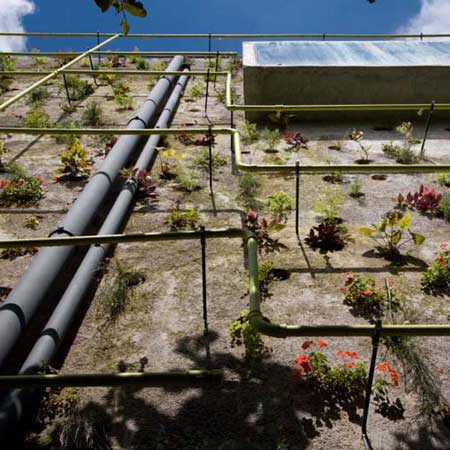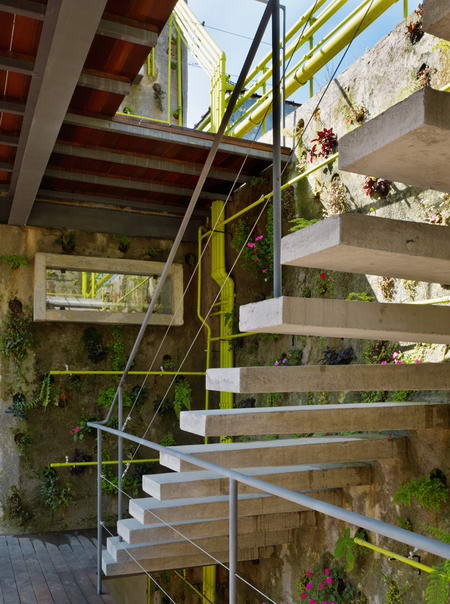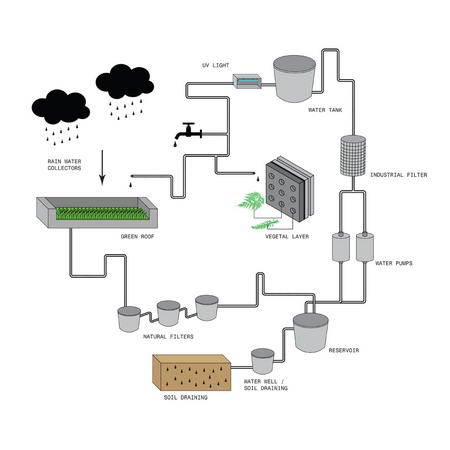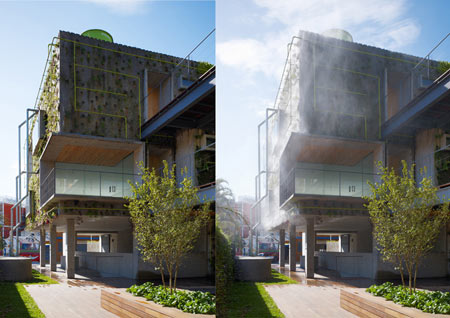tobias revell a british interaction designer, has documented the dharavi slums of mumbai, india, showcasing how genetically modified mushrooms have revitalized the poverty stricken city in the 'new mumbai' of the future. originally from amsterdam, highly experimental biotechnological samples had been stolen from a dutch lab, where the fungi had been re-engineered to exponentially grow in size for use as narcotics and to create a micro-economy based off the material. as the new plant became introduced into the overpopulated but highly educated urban mass of the slums, the locals began to use it to their advantage - to both exercise freedom from the state and to provide suitable living conditions. today, the mushroom is used to harvest energy as well as provide providing heat, light and building material
for the residents of the slums of dharavi. - From Designboom.
7.23.2012
Fungus POWER
11.20.2010
life design
Craig Venter is pretty amazing. He also has his Synthesized organism. One which he says will translate CO2 to fuel. Think about it. Self replicating species whose parent was a computer.
Hello Singularity. Is that you at my cell wall?
10.23.2010
ACADIA 2010

So I am here right now- there is a lot to write about yet I won't attempt this right now. Just to give a small overview and highlights. Speakers that spoke this morning were :
Alessandra Ponte, Associate Professor, University of Montreal, Alberto T. Estevez, Director Biogenetic Architecture Universitat Internacional de Catalunya, Jenny Sabin, Lecturer, University of Pennsylvania, Tomasz Jaskiewicz, Scott Crawford.
Currently in a pleasant overload of information. On day 3 of the conference. I need a moment to digest.
Sad not to see the gentlemen from the BIOS Design Collective not here.
9.04.2010
an answer to the archaic?
Rachel Armstrong is hitting home. I was talking about biomemetics in architecture as way of self organizing cells (and repairing them self.)
 She also talks about metabolic materials. Not far off from what was proposed in the Inhabitable Organism (our METABOLISM!!!!)
She also talks about metabolic materials. Not far off from what was proposed in the Inhabitable Organism (our METABOLISM!!!!)Rachel Armstrong is not an architect. She is a medical doctor, multi-media producer, science fiction author and arts collaborator. Through her current research that explores architectural design and mythologies about new technology, she has been working with scientists and architects to explore cutting-edge, sustainable technologies. 
Though I don't see her idea's too far off or "futuristic", Armstrong believes cities will be able to replace the energy they draw from the environment, respond to the needs of their populations and eventually regarded as "living" similar to parks or gardens. (I guess she was a big fan of Ecotopia as well....) This is also similar to point others have made about Open Source Urbanism (as the natural world can be considered as open source... let's think about mulit-poos.)
"Scientists need to work outside their own areas of expertise to make new technologies that are pertinent to the 21st century and to collaborate, both with other scientific disciplines and the arts and humanities."Rachel Armstrong
(I KNOW RIGHT?!)

8.29.2010
in Social Media Publicity grows like cancer
Mitchell Joachim
| The Colbert Report | Mon - Thurs 11:30pm / 10:30c | |||
| Mitchell Joachim | ||||
| www.colbertnation.com | ||||
| ||||
8.23.2010
pee shit bricks...
 Waste not want not? Well, Ginger Krieg Dosier, an assistant architecture professor at the American University of Sharjah in the United Arab Emirates, is making what some call waste into building materials. What if we could grow and cultivate architectural materials by employing natural minerals and microorganisms?
Waste not want not? Well, Ginger Krieg Dosier, an assistant architecture professor at the American University of Sharjah in the United Arab Emirates, is making what some call waste into building materials. What if we could grow and cultivate architectural materials by employing natural minerals and microorganisms?
The built environment that we all know and sometime love consists as is a limited palette of traditional, static materials such as concrete, glass, steel, and wood. These materials embody high concentrations of energy, with most components of concrete and steel mined from non- renewable resources. Not that great for the sustaining the environment or leaving a minimal carbon foot print. (Though LEED and other associations will give you brownie points otherwise....) Did you know 40% of global carbon dioxide is linked to the construction industry, primarily due to material production and disposal? So why not "grow" bricks? Biologically grown materials can be pollution free (note can be- they might just have a lower production of waste until we figure out how to recycle it). These grown materials also have the potential to contain a low embodied energy and could be produced as part of a local ecosystem.

Dosier has been working on a new breed of biologically “grown” bricks that are durable, sustainably manufactured, and easily produced from readily available materials. These “Better Bricks,” can be “grown” from sand, common bacteria, calcium chloride, and urea. (There's the pee again!) Growing bricks instead of being baking them, which consumes a ton of energy, saves and produces a great amount of energy!
Something to think about. I know it has been a while- but I have just been occupied with settling down in my new home/city/etc. Inhabitable Organism is on the rise! And I have a feeling it will be a pissing good time....
8.22.2010
pee power again!!?!

Youtricity, a research group of the Engineering & Physical Sciences at Heriot-Watt University, is developing the world's first Direct Urea Powered Fuel Cells. They are focusing their efforts to water treatment/purification and renewable energy where urea is a contamination problem.
This revolutionary new fuel cell takes in urine and out comes electricity and clean water. Brilliant! This would mean wonders for third world energy and clean water problems.
How does this magic work? The fuel cells convert chemical energy into electricity through a series of reactions between a fuel and an oxidant. Urea is a great (and redily) replacement hydrogen or methanol fuels. The only catch is that the batteries don't store any chemical energy inside them. This means they can only operate when external fuel sources are supplied. So keep drinking that aqua.
This yellow wonder is the brainchild of Doctors Shanwen Tao and Rong Lan. It uses cheaper materials for its membrane and catalysts. It uses a non-toxic, non-combustible fuel: urine. Talk about reducing your carbon foot print. Did you also know that urea is also known as carbamide? Urea is not strait urine and comes from humans and mammals. These batteries work with both.
Dr. Tao explained his inspirations::::
"Growing up in rural eastern China I was aware of the use of urea as an agricultural fertilizer. When I became a chemist and was looking at fuel cell development I thought of using it in the process. We are only at prototype stage at present, but if this renewable material can be used as a commercially viable and environmentally friendly energy source then we will be absolutely delighted, and many people around the world will benefit."
Urea elsewhere- it is being used in trucks and other heavy-duty vehicles to reduce nitrous oxide emissions. Other interesting urea items are Urea-formaldehyde, aka pee plastic! This is a non-transparent thermosetting resin or plastic. These resins are closer to you than you think. They are used in adhesives, finishes, MDF, and molded objects. It also has a high tensile strength and used to glue wood together! Ah, the resources we piss away everyday!
7.08.2010
Wave Power!
In the 1940's the modern scientific pursuit of wave energy was pioneered by Yoshio Masuda. His experiments tested various concepts of wave energy devices at sea, with several hundred units used to power navigation lights. In 1973, a new interest was invigorated due to the oil crisis then.
Some other things being done now --- an Australian company BioPower Systems uses the biomimicry of the floats of swaying sea plants in the presence of ocean waves in its BioWave system. The Oyster wave energy converter (featured in the video) is a hydro-electric wave energy device. The wave energy device captures energy from nearshore waves and converts it into usable electricity.
Wave- cool!
3.27.2010
bees breeze.
 With all the interest in swarming and termites, what happened to the bees ingenuity from the populous spectrum? In Syria, one of the traditional Middle Eastern construction keeps cool with out electric hungry HVAC systems. These "beehive" homes are located along the Aleppo and Euphrates Rivers. How they work in keeping the inhabitants cool is through their thick mud brick walls that trap in the cool and keep out the sun. Due to the mass they are similar to Trombe Walls for passive solar heating and cooling. They also let little light in but do have some openings for ventilation. The high dome structures move the hot air away from residents sleeping on the bottom.
With all the interest in swarming and termites, what happened to the bees ingenuity from the populous spectrum? In Syria, one of the traditional Middle Eastern construction keeps cool with out electric hungry HVAC systems. These "beehive" homes are located along the Aleppo and Euphrates Rivers. How they work in keeping the inhabitants cool is through their thick mud brick walls that trap in the cool and keep out the sun. Due to the mass they are similar to Trombe Walls for passive solar heating and cooling. They also let little light in but do have some openings for ventilation. The high dome structures move the hot air away from residents sleeping on the bottom.
The walls and exterior skin is used as a translator of energy. (passive) Imagine if the the dirt and bricks were embedded with photovoltaic chips as well or chloroplast-like cells that could not only keep the building cool and warm but transfer the energy to light and power for the inhabitants. This existing "dead" system could have a new life of its own.
Chloroplasts, the organelle that turns light into energy through photosynthesis, have been the long time inspiration for the solar panels as we know them. To this point they are still large and not nearly as integrated as their original inspiration. But let's get a bit smaller. Material scientists at the Nano/Bio Interface Center of the University of Pennsylvania have taken it there. They have demonstrated the transduction of optical radiation to electrical current in a molecular circuit. The system, consisting of an array of nano-sized molecules of gold, respond to electromagnetic waves by creating surface plasmons that induce and project electrical current across molecules, similar to that of photovoltaic solar cells.
Dawn Bonnell, a professor of materials science and the director of the Nano/Bio Interface Center at Penn, and colleagues fabricated an array of light sensitive, gold nanoparticles, linking them on a glass substrate. By minimizing the space between the nanoparticles to an optimal distance, researchers used optical radiation to excite conductive electrons, the plasmons, to ride the surface of the gold nanoparticles and focus light to the junction where the molecules are connected. This plasmon effect increases the efficiency of electrical current production in the molecule by a factor of 400 to 2000 percent, which can then be transported through the network to the outside world. Pretty amazing. These new cells could be infused into even clothing. Just think about it. 
12.25.2009
Breathing Builds
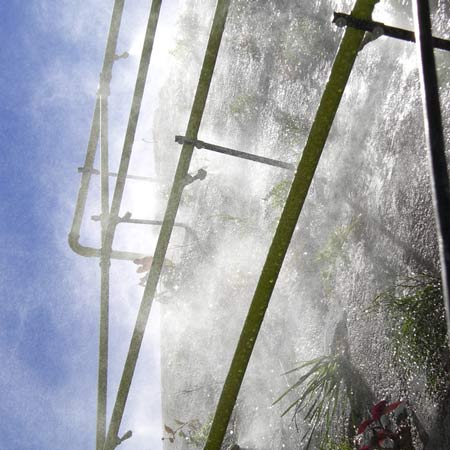 Harmonia 57 is Triptyque’s office building located in west Sao Paulo, Brazil. This building works as a living body. It breaths, sweats and modifys itself, transcending its inertia. The walls are simple, thick, and covered externally by a vegetal layer, working as the skin of the structure. This dense wall is made of an organic concrete that has pores, where several plant species grow, giving the facades a unique look.
Harmonia 57 is Triptyque’s office building located in west Sao Paulo, Brazil. This building works as a living body. It breaths, sweats and modifys itself, transcending its inertia. The walls are simple, thick, and covered externally by a vegetal layer, working as the skin of the structure. This dense wall is made of an organic concrete that has pores, where several plant species grow, giving the facades a unique look.